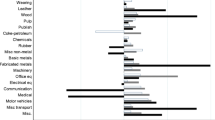Abstract
During the 1980’s, Japanese industries groped for a way to regain their comparative advantage in the international market; their solution was a restructuring into technology intensive and high value-added industries. This choice not only led to the emergence of new “high technology industries”, but also to the reformation of “old industries”. Elaborate adaptations to changes in demand and the spread of demand are now vital in order to produce high profits. Therefore, the product cycle goes faster, and high-variety small-scale manufacturing production gains greater importance than mass-production. In this situation, Research and Development (R&D) activities become very important for the continuous development of new products.
Access this chapter
Tax calculation will be finalised at checkout
Purchases are for personal use only
Preview
Unable to display preview. Download preview PDF.
Similar content being viewed by others
References
Blin, G.M. and C. Cohen, 1977, “Technological Similarity and Aggregation in Input-Output Systems: A Cluster-Analytic Approach”, The Review of Economics and Statistics, 59:82–91.
Campbell, J., 1975, “Application of Graph Theoretic Analysis to Interindustry Relationships”, Regional Science and Urban Economics 5:91–106.
Carter, J.R., 1977, “In Search of Synergy: A Structure-Performance Test”, The Review of Economics and Statistics, 59:279–289.
Czamanski, S., 1971, “Some Empirical Evidence on the Strengths of Linkages between Groups of Related Industries in Urban-Regional Complexes”, Papers of the Regional Science Association 27:137–150.
Czamanski, D.Z. and S. Czamanski, 1977, “Industrial Complexes: Their Typology, Structure and Relation to Economic Development”, Papers of the Regional Science Association 38:93–111.
Dosi, G., 1988, “Sources, Procedures arid Microeconomic Effects of Innovation”, Journal of Economic Literature 26:1120–1171.
Emerson, J. and A. Ringleb, 1977, “A Comparison of Regional Production Structures”, Papers of the Regional Science Association 39:85–98.
Florence, P.S., 1944, “The Selection of Industries Suitable for Dispersion into Rural Areas”, Royal Statistical Society Journal 107:93–116.
Hakoda, H., 1987, Diversification Strategies and Industrial Structural Change, Shinzansha, Tokyo. (In Japanese).
Hatumei Kyokai (Invention Association), 1985, “Protection and Encouragement of High Technology”, Research Report. (In Japanese).
Hewings, G.J.D., 1982, “Regional and Interregional Interdependencies: Alternative Accounting Systems”, Environment and Planning A, Vol. 14, 1587–1600.
Isard, W., E. Schooler and T. Viertorisz, 1959, Industrial Complex Analysis and Regional Development, Wiley, New York.
Larsson, J., 1989, “Product Life Cycle and Infrastructure: A Regional Perspective”, Japan-Sweden Workshop on Infrastructure of C-rich Regions.
Leontief, W., 1963, “The Structure of Development”, Scientific American.
Nelson, R.R. and S.G. Winter, An Evolutionary Theory of Economic Change, Harvard Press.
Nishiyama, K., 1985, “An Evolutionary Theoretical Model of Firms in an Industry: The Replicon Model”, IEEE Transactions on Systems, Man, and Cybernetics 15, No. 5, 662–665.
Richter, C.E., 1969, “The Impact of Industrial Linkages on Geographic Association”, Journal of Regional Science 9:19–28.
Roepke, H., D. Adams and R. Wiseman, 1974, “A New Approach to the Identification of Industrial Complexes Using Input-Output Data”, Journal of Regional Science 14:15–29.
Rumelt, R.P., 1974, Strategy, Structure and Economic Performance, Division of Research, Harvard Business School.
Slater, P.B., 1977, “The Determination of Groups of Functionally Integrated Industries in the United States using a 1967 Interindustry Flow Table”, Empirical Economics 2:1–19.
Streit, M.E., 1969, “Spatial Associations and Economic Linkages between Industries”, Journal of Regional Science 9.
Author information
Authors and Affiliations
Editor information
Editors and Affiliations
Rights and permissions
Copyright information
© 1994 Springer-Verlag Berlin · Heidelberg
About this chapter
Cite this chapter
Okumura, M., Yoshikawa, K. (1994). Measuring Horizontal Inter-Industrial Linkages. In: Johansson, B., Karlsson, C., Westin, L. (eds) Patterns of a Network Economy. Advances in Spatial and Network Economics. Springer, Berlin, Heidelberg. https://doi.org/10.1007/978-3-642-78898-7_12
Download citation
DOI: https://doi.org/10.1007/978-3-642-78898-7_12
Publisher Name: Springer, Berlin, Heidelberg
Print ISBN: 978-3-642-78900-7
Online ISBN: 978-3-642-78898-7
eBook Packages: Springer Book Archive




